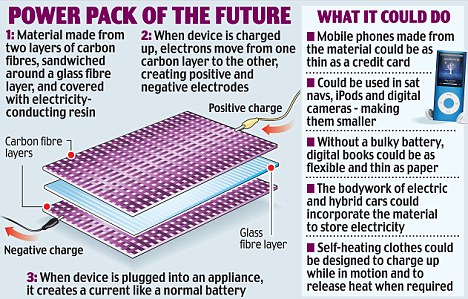New material that looks like plastic but can store electricity
The battery, which has powered our lives for generations, may soon be consigned to the dustbin of history.
British scientists say they have created a plastic that can store and release electricity, revolutionising the way we use phones, drive cars - and even wear clothes.
It means the cases of mobiles and iPods could soon double up as their power source - leading to gadgets as thin as credit cards.
Researcher Natasha Shirshova with her team’s invention
The technology could also lead to flexible computer screens that can be folded up and carried around like a piece of paper.
And it could even be used to create ‘electric clothes’ that charge up as a person moves around and which slowly release heat when the weather gets cold.
Dr Emile Greenhalgh, from Imperial College London’s Department of Aeronautics, said the material is not really a battery, but a supercapacitor - similar to those found in typical electrical circuits.
His team’s prototype - which is around five inches square and wafer-thin - takes five seconds to charge from a normal power supply and can light an LED for 20 minutes.
Dr Greenhalgh, who is working with car company Volvo on a three-year, £3million project to use the material in hybrid petrol-electric cars, said: ‘We think the car of the future could be drawing power from its roof or even the door, thanks to our material.
‘The applications for this material don’t stop there - you might have a mobile that is as thin as a credit card because it no longer needs a bulky battery, or a laptop that can draw energy from its casing so it can run for longer.’
The material charges and discharges electricity quicker than a conventional battery, and does not use chemical processes - giving it a longer lifespan, he added.
The scientists plan to use it to replace the metal floor of a Volvo car’s boot which holds the spare wheel.
This would mean Volvo could shrink the size of its hybrid battery - and cut down the weight of the car, making it more efficient.
Dr Greenhalgh said: ‘No one has created a material like this - within ten years it could replace batteries.’
